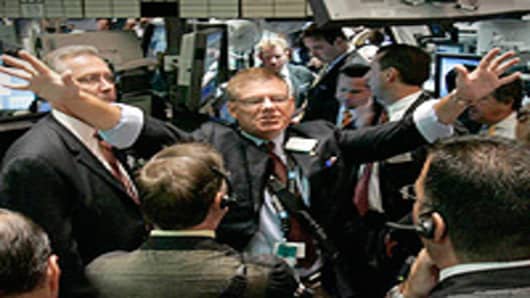Just a couple of weeks ago it looked like all was lost: Home and auto sales were falling through the floor, unemployment showed no signs of improvement and the stock market was threatening to breach its summertime low.
Since then, manufacturing showed modest signs of recovery, unemployment turned out not as ugly as imagined, and the Standard & Poor's 500 is back above the psychologically important 1,100 level.
It appears that the "less-bad trade"—when the market gets a lift from things not being as bad as expected—has returned to Wall Street.
"Double-dip talk had been headline news for months. The thing a double-dip is also associated with is a pronounced decline in the equity markets," says Quincy Krosby, general strategist at Prudential Financial in Newark, N.J. "Once we were able to move double-dip talk off the front page by assuaging investor fears with better than expected macroeconomic data, investors felt better."
The result has been a two-week rally of about 5.5 percent in the S&P 500 and a sharp bullish surge in investor sentiment.
The American Association of Individual Investors weekly survey, which just two weeks ago reflected bullish sentiment of 21 percent—its worst reading since just before the March 2009 stock market lows—has more than doubled to 44 percent.
All this while the unemployment rate actually went up to 9.6 percent, a much-touted Institute for Supply Management reading actually saw contraction among its leading indicators, and there were only modest improvements elsewhere.
So what has changed in two weeks?
"Here you have signs that we really could be going into a double-dip recession. People for the most part are optimists by nature and are hoping for something better," says Abigail Doolittle, founder of Peak Theories Research in Albany, N.Y.
Doolittle thinks ultimately the stock market is heading for "the worst bear market of our collective lifetimes" but in the near- to mid-term is actually forming an inverse head-and-shoulders chart pattern higher.
Both Doolittle and Krosby say some more concrete forms of macroeconomic data improvementwill have to appear to confirm the rally.
"If there is a rally of some sort nobody wants to miss out on it," Doolittle says. "But that in and of itself is not really going to create longer-term buying. It's enough to get us where we are now, but for the S&P to continue to move up something good is actually going to have to come out."
Indeed, other trends in the market continue to look foreboding for a major move higher.
Investors continue to flock to bond funds, pulling $513 million out of equity mutual funds and putting $2.5 billion into bond funds last week, according to Lipper data.
But the averages continue to trudge higher, rising even though September is historically the market's worst month.
Stocks rallied 7.2 percent in July on the strength of a solid earnings season, but then gave back about 2 percent in August as the weak economic data continued to pile in. Most strategists see investors at this point far more fixed on the economy than company performance, though that could change as industry conference season kicks into gear in the coming weeks.
"Macroeconomic data is continuing to drive equity prices," says Tim McCandless, senior equity strategist at Bel Air Investment Advisors in Los Angeles. "As the likelihood or chance of a double-dip looks lower, equity valuations are going to be able to move higher."
Investors remain cautious, however.
While the CBOE Volatility Index remains low, the November futures contracts are trading at 28.70, a sign that options traders are expecting turbulence heading into the third-quarter earnings season and the November elections.
But investors also know that the market can continue to rise even amid a slow-gain economy.
"This is where the market is going to need conclusive evidence to break that upper end of the trading range—conclusive evidence that leading economic indicators are turning back up," Krosby says. "That question is not going to be answered until we have a couple months of solid data."



